
Chapter 6. Accessing data
The 3ESPCD has six different transmission modes, which control whether the instrument transmits data via the serial port or network interface, stores data into its flash memory or some combination of both. Transmission modes are described in section 5.2.6.5.
If you choose a transmission mode where data are transmitted in real time, you can receive the data using Güralp Systems’ free Scream! software or using a Güralp EAM, Güralp NAM or similar data acquisition system.
If you choose a transmission mode where data are stored in Flash memory, you can recover these data at a later date, using either the FireWire interface or a serial link.
Note: The FireWire interface is very much faster than the serial link: the serial link is intended for real-time data transmission. If you wish to retrieve recorded data, the serial link (and the Ethernet link, if fitted) are only really useful for small, ad-hoc transfers.
The Flash memory is used as a ring buffer. Two pointers into the memory keep track of where data were last read (the “Read Pointer”) and last written (the “Write pointer”). When either pointer reaches the end of physical memory, it wraps round back to the beginning. The behaviour of the recording system when the write pointer reaches the read pointer (i.e. when the memory becomes full of data, none of which have been downloaded) is governed by the commands RE-USE/RECYCLE and WRITE-ONCE, as described in section 5.2.6.6.
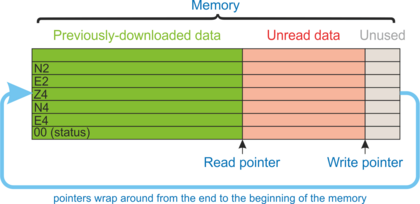
The rest of Chapter 6 describes:
receiving real-time data (section 6.1);
downloading data over FireWire to a hard drive (section 6.2.3);
reading the data from the hard drive onto a PC (section 6.2.4); and
downloading data over the serial port or Ethernet interface (section 6.3).
6.1 Streaming data
When a good-quality communications link exists, data can be streamed from the instrument to either a PC running Güralp Systems’ free Scream! software or to a data acquisition system, such as a Güralp EAM or a Güralp NAM.
Where the communications link is intermittent, such as a dial-up modem, the instrument can be configured to store data in its flash memory and then initiate transmission whenever the link becomes available.
Data are sent in GCF format using the BRP protocol. For more information, please see the document "What is the GCF format", accessible from the Support→FAQs section of our web site.
6.1.1 Receiving streaming data in Scream! via a serial port
Note: Scream! software is available free of charge. Scream is available for both Windows and Linux computers. To request a copy, please send an email to scream@guralp.com stating your name, any organisational affiliation, the equipment you have and the nature of your work.
Your instrument can connect directly to your computer using a serial cable from the break-out box. If your computer does not have a COM port, a serial-to-USB adapter can be used. Güralp recommend serial-to-USB adapters based on the FTDI chip-set.
To receive the data in Scream:
Start Scream and select Setup from the File menu.
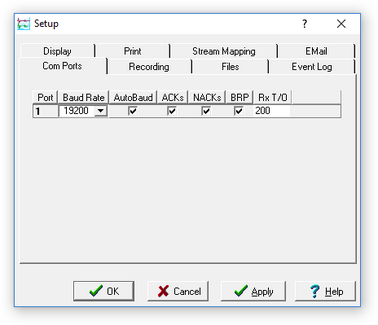
Go to the COM Ports tab and locate the entry for the port that is connected to the instrument. If you are using Windows, the Port number corresponds to the COMn number of the serial port. If you are using Linux, ports one to sixty-four (inclusive) refer to the built-in serial ports /dev/ttyS0 – /dev/ttyS63. Ports 65 and above refer to USB serial ports beginning /dev/ttyUSB0. Subtract 65 from the port number to get the ttyUSB number. For more information, please see the Scream manual - MAN‑SWA‑0001.
Use the drop-down menu to set the port's Baud Rate to match that of your instrument. If you have not changed it, this will be 38,400 Baud.
Within a few seconds, you should see blocks appearing in the Block Rx pane, and streams will appear in Scream!'s main window. Close the Setup dialogue.
6.1.2 Receiving streaming data in Scream! via a network
Note: Scream! software is available free of charge. Scream is available for both Windows and Linux computers. To request a copy, please send an email to scream@guralp.com stating your name, any organisational affiliation, the equipment you have and the nature of your work.
Before you can do this, you will need to set up the instrument's IP address and network configuration, as described in section 4.8 (wired) or section 4.9 (wireless).
To connect to a 3ESPCD over the network:
Run Scream!, and select Windows → Network Control from the main menu. Click on the My Client tab.
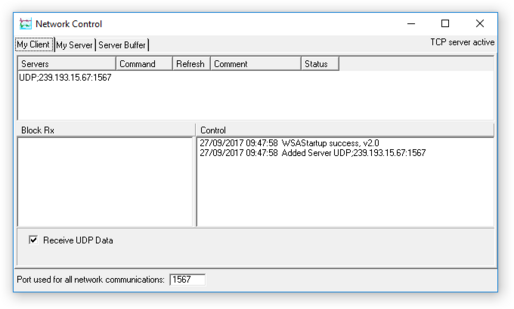
Ensure that the check-box marked “Receive UDP Data” is ticked.
Right-click in the white panel beneath Server, and select Add TCP Server….
Type the IP address of the 3ESPCD, a colon (“:”) and the output port that you chose when configuring the network interface. If you accepted the defaults, this will be port 10,002. The entry should look like
92.168.33.2:10002
Click
 .
.After a short wait, an entry for the instrument should appear in the pane. Right-click on the entry and select Connect.
9If the connection is successful, you should see blocks appearing in the Block Rx pane, and streams will appear in Scream!'s main window. Close the Network Control window.
6.1.3 Receiving streaming data in an EAM via a serial port
To receive data in an acquisition module such as a Güralp EAM or a Güralp NAM:
From the web interface, select Serial ports from the Configuration → Data handling menu.
Click the
 button next to the desired port
button next to the desired portIn the resulting dialogue, set the port function to GCF in (BRP) and the Baud rate to 38400 (unless you have changed this in the instrument). Leave the other fields as shown:
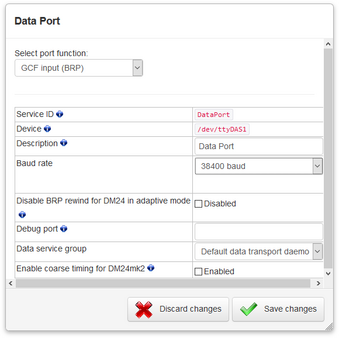
Click the
 button.
button.Browse to the Summary → System status page. A new tab will have appeared showing your configured serial port. It will be shown in grey initially but, as data arrive, it will change to amber and, after a few minutes, green.
6.1.4 Receiving streaming data in an EAM via a network
Before you can do this, you will need to set up the instrument's IP address and network configuration, as described in section 4.8 (wired) or section 4.9 (wireless).
To receive data in an acquisition module such as a Güralp EAM or a Güralp NAM:
From the web interface, select Services from the Configuration → Data handling menu.
Select the GCF tab and click gcf-in-brp - GCF BRP network client.
Click Create new service instance
Place a tick in the Enable check-box and enter the DNS name or IP address of the instrument in the Remote server field.
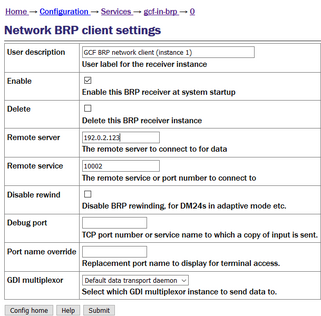
Click the
 button.
button.Browse to the Summary → System status page. A new tab will have appeared showing your configured service. It will be shown in grey initially but, as data arrive, it will change to amber and, after a few minutes, green.
6.2 Using FireWire disks
Use of a FireWire disk (attached to the instrument's FireWire connector) is the only practical way to download significant amounts of data from an 3ESPCD.
Güralp Systems provide fully-tested and ruggedised disks with both FireWire and USB connectors. Some third-party FireWire disks work with the 3ESPCD but compatibility cannot be guaranteed.
Note: The 3ESPCD requires the disk to be in DFD format. If the disk has not previously been used with a CD24, 3ESPCD or 6TD, it must first be initialised using the instrument itself. Once initialised the first time, it can then be reinitialised in the same way or by use of Scream or GCFXtract software.
6.2.1 Initialising disks
Before you can use each FireWire disk, you will need to erase/format it. The digitiser saves data on the hard disk in "raw" mode, so you cannot use a PC's standard disk-management software to reset the disk. The format used is called DFD.
A disk which is already in DFD format can be reformatted as a DFD volume - i.e. cleared of all data and prepared for re-use with your instrument - using the instrument itself or using PC software: Scream or GCFXtract.
A disk which is not already in DFD format can only be reformatted as a DFD drive by using the instrument. This is to prevent you from accidentally reformatting your PC's hard drive as a DFD volume.
To erase/format a FireWire disk for use with the instrument:
Power up the instrument, and connect it to your computer's serial port.
Open its terminal console. To do this using Güralp Systems' Scream! software, right-click on the digitiser's icon (once it appears) and select Terminal....
Plug in the disk and attach a suitable power supply
Issue the command RESET-DISK (see section 9.8.13 for details)
If there is no disk connected, the power supply is not connected or the cable is faulty, you will see the message
FW Ierr
When the reset is complete, remove the disk.
You will now be able to download data onto the disk when required.
6.2.2 Reinitialising disks
A disk which is already in DFD format can be reinitialised as a DFD volume using the procedure described in section 6.2.1 or by the use of software, as described below.
Reinitialising a DFD disk does not erase any data: it simply marks the disk as available for over-writing. If you accidentally reinitialise a DFD disk, you will still be able to extract data from it using GCFXtract as long as you do not write any new data to it.
Note: Depending on your security settings, you may need elevated privileges in order to read DFD disks. Windows users may need to start Scream! or GCFXtract by right-clicking on the icon or start-menu entry and selecting Run as administrator… from the context menu. Linux users may need to add their username to the disk group (or to another group with raw disk access) with a command like
sudo usermod --append -G group my_username
Caution: When a DFD disk is connected to a Windows PC, the operating system will not recognise the file-system and will offer to re-format it.
Do not allow it to do so: you will lose some data from the disk and make it hard to recover the rest. If you accidentally find yourself in this position, please contact support for advice.
6.2.2.1 Reinitialisation using Scream
To re-initialise a disk using Scream, connect the disk to a PC running Scream and select File → Reset SCSI disk... from the main menu. Once the reset is complete, simply disconnect the disk.
6.2.2.2 Reinitialisation using GCFXtract
To re-initialise a disk using GCFXtract, connect the disk to a PC running GCFXtract. Select the disk from the drop-down menu and click  . Once the reset is complete, simply disconnect the disk.
. Once the reset is complete, simply disconnect the disk.
6.2.3 Downloading data to a FireWire disk
The easiest way to download data over FireWire is to connect a suitable disk to the FireWire port of the 3ESPCD and power cycle the instrument.
If you have ordered a 3ESPCD with the powered FireWire option, you can attach the disk directly to the 3ESPCD with no additional connections. Otherwise, you will need to connect the disk to a power source through the supplied adapter.
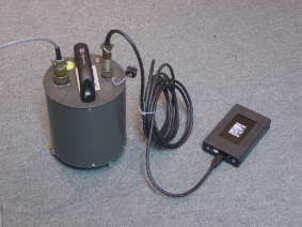
When the sensor restarts, it will automatically the disk and flush all new data to it.
If you do not want to restart the instrument, you can also flush data to disk manually:
Open the digitiser's console.
If you are using Güralp Systems' Scream! software, right-click on the digitiser's icon (once it appears) and select Terminal….
If you are using a Güralp EAM, select FORTH terminal access from the Tools → Instruments menu and select the digitiser from the resulting menu.
Connect a suitable disk to the FireWire port of the 3ESPCD. Power the disk if necessary.
Issue the command FLUSH
This will download all data from the 3ESPCD that it has not already marked as having been transferred. If you want to transfer the entire contents of Flash memory, use the command FLUSHALL. For more details, see section 9.8.12.
If you are using Scream! or an EAM, the instrument should start transmitting immediately when you close the terminal session. Otherwise, you may need to issue the command GO to start transferring data before closing the session.
6.2.4 Reading FireWire disks
The 3ESPCD uses a special disk format, DFD, for recording data. This format is also used by other Güralp digitisers such as the DM24.
You can read this data into a PC using Scream! or the GCFXtract utility, both of which are freely available from the Güralp Systems web site.
Note: The DFD format is not the same as that used by the Güralp Systems EAM data module, which uses an ext3, ext4 or a FAT32-compatible journaling file system.
To read a disk using GCFXtract:
Attach the disk to your computer using either the FireWire or USB interface.
Caution: When a DFD disk is connected to a Windows PC, the operating system will not recognise the file-system and will offer to re-format it. Do not allow it to do so: you will lose some data from the disk and make it hard to recover the rest. If you accidentally find yourself in this position, please contact support for advice.
Run GCFXtract and select the required disk from the drop-down list, then click
 .
.GCFxtract will scan the disk and display all the streams it finds in the selection area below. For each stream, the Stream ID and the number of blocks found are shown.
This operation requires roughly 12 Mb of available memory for every Gb of space on the disk. If you have a very large disk, your computer may have to use its hard disk to make enough space. This will slow down scanning considerably.
By default, all streams containing more than 100 blocks are selected for extraction. You can change which streams to extract by ticking or clearing the check box beside each stream.
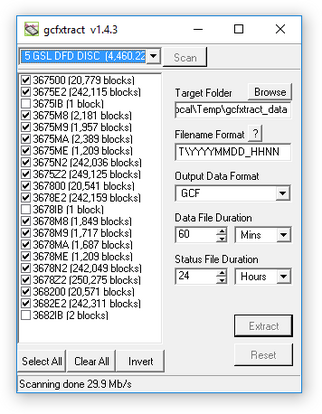
You can tick or clear all of the boxes using the
 and
and  all buttons. Clicking
all buttons. Clicking  ticks all empty boxes, and clears all ticked boxes.
ticks all empty boxes, and clears all ticked boxes.Enter a path name into the Target Directory field, or use the
 button to find a directory. This will be used as the root directory for extracted data. If it does not exist, GCFXtract will create it.
button to find a directory. This will be used as the root directory for extracted data. If it does not exist, GCFXtract will create it.Enter a format string into the Filename Format field. The syntax is the same as the format string in Scream! and full documentation is available by pressing the
 button beside the format entry field in interactive mode.
button beside the format entry field in interactive mode.Normally, GCFxtracgcfxtract outputs GCF files, to ensure all the information in the original data is retained. If you want to convert to a different format, select it from the Output Data Format drop-down box. GCFXtract can output in most of the formats supported by Scream!.
Data are automatically placed in time order and saved in multiple files, each file containing a contiguous segment of data. By default, data streams are recorded in files sixty minutes long. To change this to some other number of minutes, alter the value in the Data File Duration box. The units (minutes by default) can be selected using the adjacent drop-down menu.
For data streams, if there is a gap in the data, GCFXtract will start a new file anyway.
Status streams are also saved in in multiple files, but have a default length of 24 hours. To change this, alter the value under Status File Duration. The units (hours by default) can be selected using the adjacent drop-down menu.
When you are happy with the settings, click
 to begin extracting the data.
to begin extracting the data.Clicking
 sets a flag on the disk which marks it as empty. The next time a digitiser transfers data, it will begin at the beginning of the disk, overwriting the old data. When this happens, none of the old data can be extracted with GCFXtract or Scream!. Until then, however, you will still be able to retrieve all the data.
sets a flag on the disk which marks it as empty. The next time a digitiser transfers data, it will begin at the beginning of the disk, overwriting the old data. When this happens, none of the old data can be extracted with GCFXtract or Scream!. Until then, however, you will still be able to retrieve all the data.When you are finished, you should exit GCFxtracgcfxtract and then use your operating system's standard facility for un-mounting hardware (e.g. “Safely Remove Hardware” under Windows) before disconnecting the drive.
You can also read disks with Scream!. This allows you to view data in the process of being transferred, but is slightly slower, because Scream! does not read data in strict order. To read a disk with Scream!:
Attach the disk to your computer. You can use FireWire, USB, or any other interface supported by your computer and the disk.
Run Scream!, and select File → Setup… from the main menu. Select the Files tab.
Set the Base Directory, Filename Format and Data Format as described above. Also, if required, set the Post-processor and Granularity options to your preference. Consult the Scream! documentation for details.
Select the Recording tab and tick Auto Record - Enable for Data Streams and Auto Record - Enable for Status Streams. Click
 .
.Scream! will remember the recording options you set in steps 3 and 4 for later occasions.
Select File → Replay SCSI disk… from the main menu. Scream! will search for attached disks, and open a window with a list of all the streams it has found.
Select the streams you want to replay, and click
 . The disk will appear in the left-hand pane of Scream!'s main window, and the streams you have selected will start playing into the stream buffer, as well as being recorded.
. The disk will appear in the left-hand pane of Scream!'s main window, and the streams you have selected will start playing into the stream buffer, as well as being recorded.When you have finished transferring the data, if you want to reset the disk, select File → Reset SCSI disk… from Scream!'s main menu. Select the disk you want to reset, and click
 .
.
6.3 Downloading recorded data over the serial port or Ethernet interface
Note: This technique is not recommended for transferring significant quantities of data, because of the speed limitation. The FireWire interface should be used for this purpose: see section 6.2.3.
Start by configuring Scream to record all incoming data by visiting the “Recording” tab of the File→Setup dialogue:
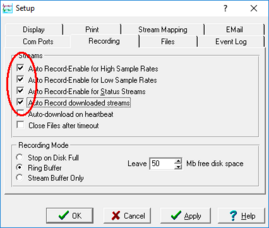
Ensure that the first four check-boxes are ticked. Next, switch to the “Files” tab and choose an appropriate base directory, file format and filename format.
Click  to save your changes and close the dialogue.
to save your changes and close the dialogue.
Next, open a connection to the digitiser's console. To do this using Güralp Systems' Scream! software, right-click on the digitiser's icon ( ) and select Terminal…. From a Güralp EAM, issue the command
) and select Terminal…. From a Güralp EAM, issue the command
data-terminal
and select the appropriate data source from the menu.
To simply download all data held in the Flash memory, issue the command
ALL-FLASH ALL-DATA DOWNLOAD
followed by
GO
This will initiate a complete download. The ALL-FLASH and ALL-DATA commands act as modifiers to tell the system what to download.
If you wish to download only a subset of data, you can replace the ALL-FLASH and ALL-DATA modifiers with other modifiers to select different streams and/or time periods:
The streams to be downloaded are specified with ALL-DATA, S/S, or STATUS-ONLY.
Any desired time period can be specified with ALL-FLASH, ALL-TIMES, or FROM-TIME and/or TO-TIME.
The parameters are illustrated in the diagram below. If you miss out a parameter, DOWNLOAD will re-use the value you last specified.
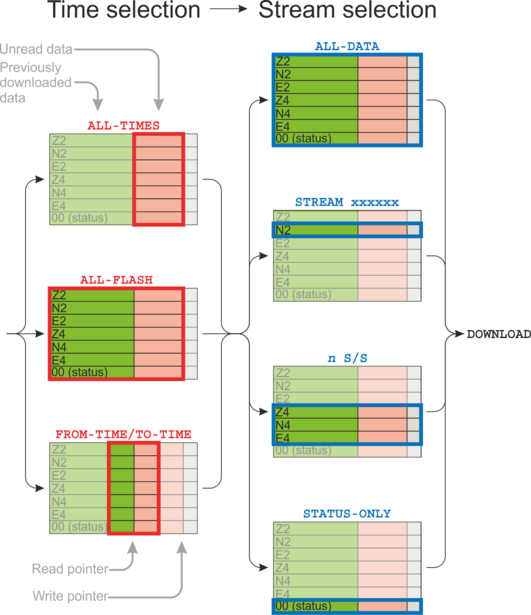
Note: You can pause a download by entering terminal mode, and either restart with another GO or abort with END-DOWNLOAD.
When you complete a DOWNLOAD without specifying a time period, the CD24 adjusts the internal read pointer to mark the latest position. This is then used as the start point for the next DOWNLOAD with the command ALL-TIMES.
The various modifiers are are summarised below and described in detail in section 9.8.
Time selection
ALL-TIMES – select all data that have not been previously downloaded
ALL-FLASH – select all recorded data
FROM-TIME / TO-TIME – select data between two user-specified times
Stream selection
ALL-DATA – select all recorded streams
STREAM xxxxxx – select only the specified stream xxxxxx
n S/S – select only streams with sample rate n
STATUS-ONLY – select only status streams (equivalent to 0 S/S)
The DOWNLOAD command returns immediately, so that you can issue more commands if required. To close the connection and begin downloading with the specified selectors, issue the GO command.
Once the GO command has been issued, the window may close, depending on which emulator you are using. On an EAM, the data-terminal (minicom) session is closed by keying  +
+ , then
, then  .
.